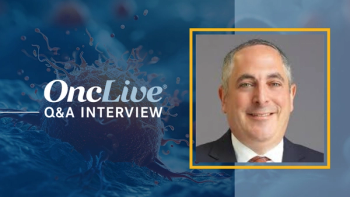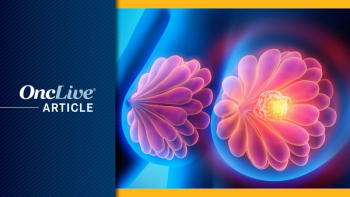
Osimertinib/Savolitinib Combo Looks to Overcome Acquired Resistance in EGFR-Mutant NSCLC
Acquired resistance because of genetic alterations in the MET receptor has limited the efficacy of the EGFR inhibitor osimertinib in patients with non–small cell lung cancer. Investigators have sought to circumvent this barrier through targeting MET protein activity with the addition of the novel MET TKI, savolitinib.
Acquired resistance because of genetic alterations in the MET receptor has limited the efficacy of the EGFR inhibitor osimertinib (Tagrisso) in patients with non–small cell lung cancer (NSCLC). Investigators have sought to circumvent this barrier through targeting MET protein activity with the addition of the novel MET tyrosine kinase inhibitor (TKI), savolitinib.1
“Osimertinib is the preferred first-line treatment in EGFR-mutant advanced NSCLC; however, tumors can develop resistance,” investigators wrote in a poster presented during the 2022 International Association for the Study of Lung Cancer World Conference on Lung Cancer Annual Meeting.2 “MET overexpression and/or amplification is the most common resistance mechanism to osimertinib, despite this, there is no approved targeted therapy for these patients. Platinum-based chemotherapy remains the standard of care, with limited efficacy.”
A preliminary efficacy analysis of the combination of savolitinib plus osimertinib demonstrated an improvement in outcomes among patients with EGFR-mutant NSCLC with MET overexpression following disease progression on osimertinib.1 Investigators of the phase 2 SAVANNAH study (NCT03778229) performed a baseline analysis for MET overexpression and amplification using immunohistochemistry (IHC; 3+ in ≥ 50% of tumor cells) and fluorescence in situ hybridization (FISH; MET copy number ≥ 5 and/or MET:CEP7 signal ratio ≥ 2), respectively.1
Overexpression and amplification in the overall population were IHC50+ and FISH5+, respectively. Subgroup analyses were performed among patients with or without IHC90+ and FISH10+.
At data cutoff, 196 patients were treated and 193 were available for efficacy evaluation. Patients received oral savolitinib 300 mg twice daily in combination with oral osimertinib 80 mg once daily. The objective response rate (ORR) was 32% (95% CI, 26%-39%) with a median duration of response (DOR) of 8.3 months (95% CI, 6.9-9.7). the disease-control rate was (DCR) was 61% (95% CI, 53%-68%). The median progression-free survival (PFS) was 5.3 months (95% CI, 4.2-5.8).1
Among patients IHC90+ and/or FISH10+ (n = 108), the ORR was 49% (95% CI, 39%-59%) with a median DOR of 9.3 months (95% CI, 7.6-10.6). The DCR was 74% (95% CI, 65%-82%). The median PFS was 7.1 months (95% CI, 5.3-8.0). Investigators noted that although the DOR is not fully mature, with a median follow-up of 13 months, the responses in this subgroup appear to be durable.1
A reduced clinical benefit was observed among patients without ICH90+ and/or FISH10+ status (n = 77). The ORR was 9% (95% CI, 4%-18%) with a median DOR of 6.9 months (95% CI, 4.1-16.9%). The DCR was 43% (95% CI, 32%-55%) and the median PFS was only 2.8 months (95% CI, 2.6-4.3).
Among 196 patients in the safety analysis set (n = 196), the median age was 63 years (range, 34-86) and 62% were women. Most patients had an ECOG performance status of 1 (63%) and no central nervous system involvement at study entry (66%).
Adverse effects (AEs) were of any grade were reported among 99% of patients with 84% of AEs related to any study treatment. Grade 3 or higher AEs were reported among 45% of patients, 20% of patients experiencing grade 3 or higher AEs related to study treatment. Serious AEs were reported in 29% of patients, 7% of which were related to the study treatment.
Twenty-six patients discontinued treatment due to AEs related to savolitinib and 21 patients due to osimertinib AEs. The median duration of treatment with savolitinib was 4.8 months (range, 0.1-25.7) and 4.9 months (range, 0.1-25.7) with osimertinib.
The most common grade 3 or higher AEs were pulmonary embolism (5%), dyspnea (4%), neutrophil count decreased (4%), pneumonia (4%), hypoalbuminemia (2%), pleural effusion (2%), vomiting (2%), and anemia (2%). Further, 1 patient each reported grade 3 or higher hypersensitivity and interstitial lung disease/pneumonitis, respectively.
Investigators Push MET/EGFR Inhibition to Phase 3
Leveraging the improved outcomes from SAVANNAH, investigators have initiated the phase 3 SAFFRON trial (NCT05261399). The randomized study will evaluate the safety and efficacy of savolitinib in combination with osimertinib vs standard-of-care platinum doublet chemotherapy. The primary end point if PFS with secondary end points of overall survival, ORR, DOR, DCR, time to discontinuation and tumor shrinkage.
Eligibility for enrollment requires that patients have EGFR-mutant, MET-overexpressed or -amplified, locally advanced or metastatic NSCLC who have disease progression of first- or second-line osimertinib.2 Disease progression occurred less than 6 months after the last dose if osimertinib was administered in the adjuvant setting. Patients must be 18 years or older, expect in Japan where the minimum age for enrollment is 20 years.
Individuals are not eligible if they have active gastrointestinal disease, selected cardiac diseases, severe or uncontrolled systemic disease, active hepatitis B or C infection, active infections (HIV or tuberculosis) and/or liver disease. Those with predominant squamous cell histology and symptomatic brain metastases are also ineligible.
Stratification factors include second vs third line therapy, baseline brain metastases (yes vs no), and race (Asian vs non-Asian). Upon disease progression investigators can determine if patients will continue to receive treatment with the combination or osimertinib monotherapy if a clinical benefit is observed.
The primary analysis of the study is expected in June 2025.
References
- Ahn MJ, de Marinis F, Bonanno L, et al. MET biomarker-based preliminary efficacy analysis in SAVANNAH: savolitinib+osimertinib in EGFRm NSCLC post-osimertinib.Presented at: International Association for the Study of Lung Cancer 2022 World Conference on Lung Cancer; August 6-9, 2022; Vienna, Austria. Accessed August 5, 2022. bit.ly/3Sn1fZs
- Lu S, Xu W, Telaranta-Keerie A, Jia N, Hartmaier R. SAFFRON: ph3 savolitinib + osimertinib vs chemotherapy in EGFRm NSCLC with MET overexpression/amplification post-osimertinib. Presented at: International Association for the Study of Lung Cancer 2022 World Conference on Lung Cancer; August 6-9, 2022; Vienna, Austria. Accessed August 5, 2022. bit.ly/3BIt5cM

























































































